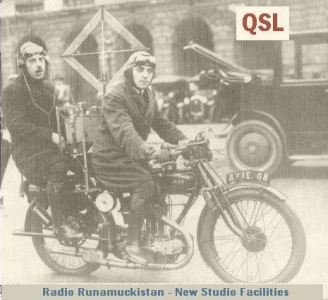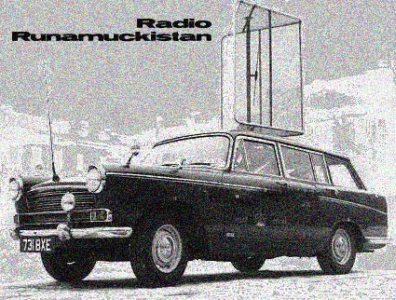Radio Runamuckistan
 Radio Runamuckistan is one of the more unusual cases of a radio station reflecting the culture of its country. Now an integral part of Kazakhstan, Runamuckistan was an "autonomous oblast" within Kazakhstan in the old Soviet Union from 1927 until begin absorbed into Kazakhstan in 1974. For at least a thousand years, the Runamuckistanis were the most nomadic of Central Asia's many ethnic groups. In the 1920s, the Soviet government forced the Runamuckistanis to settle in a small area north of the Aral Sea, which became the Runamuckistan Autonomous Oblast.
Radio Runamuckistan is one of the more unusual cases of a radio station reflecting the culture of its country. Now an integral part of Kazakhstan, Runamuckistan was an "autonomous oblast" within Kazakhstan in the old Soviet Union from 1927 until begin absorbed into Kazakhstan in 1974. For at least a thousand years, the Runamuckistanis were the most nomadic of Central Asia's many ethnic groups. In the 1920s, the Soviet government forced the Runamuckistanis to settle in a small area north of the Aral Sea, which became the Runamuckistan Autonomous Oblast.
As the Runamuckistanis had an oral culture, the Stalinist government saw radio as the key to indoctrinating these people to the new system and Radio Runamuckistan was founded in 1932. Rather than embracing the radio station, as expected, the Runamuckistanis treated it with total disdain. One of the Communist Party officials working in Runamuckistan was a young Ukrainian with a background in anthropology. By observing the local culture he soon deduced that in the traditional nomadic Runamuckistanian culture anything that is stationary is not to be respected or trusted. As long as Radio Runamuckistan broadcast from a fixed location, it could never be an integral part of the local culture. The station would have to go mobile.
 After several failures in attempting to broadcast from the back of a horse, it was decided to broadcast from a motorcyle. Having never seen a motorcycle before, the Runamuckistanis were in total awe when the station began broadcasting while roaming betweenn the collective farms on the steppes. Radio Runamuckistan connected with the local culture and brought legitimacy to the new Communist government. Additional motorcyles were added and Radio Runamuckistan continued to broadcast from its fleet of motorcyles until about 1950, when the first automobile-based stations were introduced. By the late 1960s, young Runamuckistanis were two generations removed from their nomadic past and the mobile radio stations were seen as a symbol of national embarassment. The last mobile station went of the air in early 1973, about one year before Runamuckistan ceased to exist as a political entity.
After several failures in attempting to broadcast from the back of a horse, it was decided to broadcast from a motorcyle. Having never seen a motorcycle before, the Runamuckistanis were in total awe when the station began broadcasting while roaming betweenn the collective farms on the steppes. Radio Runamuckistan connected with the local culture and brought legitimacy to the new Communist government. Additional motorcyles were added and Radio Runamuckistan continued to broadcast from its fleet of motorcyles until about 1950, when the first automobile-based stations were introduced. By the late 1960s, young Runamuckistanis were two generations removed from their nomadic past and the mobile radio stations were seen as a symbol of national embarassment. The last mobile station went of the air in early 1973, about one year before Runamuckistan ceased to exist as a political entity.
As a mobile broadcaster, Radio Runamuckistan was always low-power and there were no known loggings of it in North America and very few in Europe or Australia. The QSLs in our collection belonged to Liam Gamble, a British tea merchant and DXer who frequently traveled to the Darjeeling area of northern India. The first QSL is from 1938, and the second from 1962.